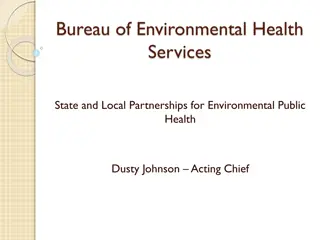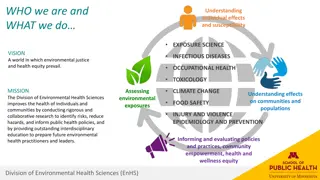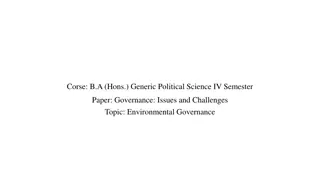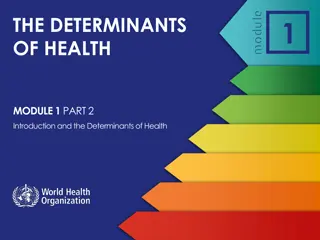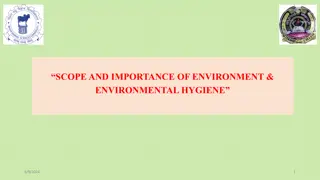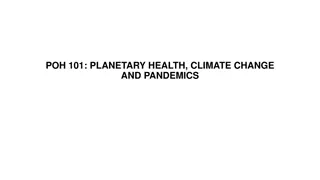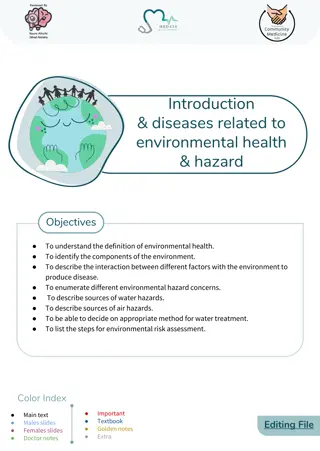Understanding Environmental Health and Its Impact on Human Well-being
Environmental health is a critical aspect of public health that focuses on assessing, understanding, controlling, and improving the influence of the environment on people and vice versa. It encompasses factors such as workplace conditions, homes, communities, and various environmental elements like chemical, physical, and psychological aspects. The World Health Organization's definition emphasizes the comprehensive nature of environmental health, including both direct health effects of agents and broader societal influences. The term "environment" encompasses not only natural elements like air, water, and soil but also the man-made surroundings formed by society, with various components contributing to human health. These components include the physical, biological, and social aspects of the environment, affecting individuals' overall well-being.
Download Presentation

Please find below an Image/Link to download the presentation.
The content on the website is provided AS IS for your information and personal use only. It may not be sold, licensed, or shared on other websites without obtaining consent from the author. Download presentation by click this link. If you encounter any issues during the download, it is possible that the publisher has removed the file from their server.
E N D
Presentation Transcript
INTRODUCTION TO ENVIRONMENTAL HEALTH BELLO C. B.
DEFINITIONS Environmental health is the branch of public health that is concerned with assessing, understanding, controlling and improving the impact of the environment on the people and the impact of the people on the environment.
The field of environmental health is concerned with all those elements of the environment that influences peoples health and well-being. The conditions of workplace, homes, communities, which also include chemical, physical, & psychological factors within the environment affect human health
The World Health Organizations (WHO, 1997) definition of environmental health as used in the Healthy People, 2010 objectives. In the broadest sense, environmental health comprises those aspects of human health, disease, and injury that are determined or influenced by factors in the environment. This includes the study of both the direct pathological effects of various chemical, physical and biological agents, as well as the effect on health of the broad physical and social environment, which includes housing, urban development, land use, and transportation, industry and agriculture
DEFINITION CONTD The term environmental health was previously referred to as environmental sanitation. the word sanitation means the science of safeguarding health. Sanitation is defined as the control of all those factors in mans physical environment which exercise or may exercise a deleterious effect on his physical development, health and survival.
THE ENVIRONMENT This definition includes not only the air, water and soil which are often used to describe the physical environment provided by the earth but also the man-made environment created by society. The environment is a collective term used to describe all the living and non-living things that make up our surroundings. These include biological, physical and social factors in our surroundings. For descriptive purpose, environment has been divided into components:
TYPES OF ENVIRONMENT Physical environment: water, air, soil, housing, wastes, radiation ,climate etc Biological environment: plants and animal life including bacteria, viruses, insects, rodents and animals Social environment: customs, culture & beliefs, habits, income, occupation, religious practices Other factors that are concerned with our environment and affect human health includes Psychological factors: nature of individual, e.g introvert and extrovert, incentives, stress Chemical factors: drugs, acids, cosmetic soaps, creams, food additives etc.
ENVIRONMENT CONTD Much of man s ill health can be traced to adverse environmental factors such as water pollution, soil pollution, air pollution, poor housing conditions. Presence of animal reservoirs and insect vectors of diseases pose a constant threat to man s health. When environmental health services are not given enough consideration, then health problem ensues.
Today about 2.4billion lack safe water supply, total population of the world is about 6 billion, 750/0 of disease are water related diseases. About 3 billion people have no access to safe method of sewage disposal, major characteristics of an environment with poor excreta disposal is poor health, they suffer from GIT disorders such as cholera About 2 million of people die every year from diarrhea dxes associated with poor hygiene, poor water supply and poor waste disposal.
ENVIRONMENT Most environmental disease affect people physically, mentally, economically and socially, some people are faced with various forms of deformity. Many hospitals are overburdened and overworked due to environmental diseases which are preventable, thus, ultimately, the environment is a key issue when discussing major socio- environmental problem.
Most times, Man is responsible for the pollution of his environment through urbanization, industrialization and other human activities. The first step in any health programme is the elimination through environmental control of those factors which are harmful to health. The purpose of environmental health is to create and maintain ecological conditions that will promote health and thus prevent disease. One of the changes needed to achieve Health for All is concerned with a healthy environment.
PURPOSE OF ENVIRONMENTAL HEALTH The purpose of environmental health is to build and preserve ecological setting that will promote health and reduce the risk or prevent disease. Sustaining a healthy environment is essential to achieving health for all Most of the ill health in developing countries is caused by environmental factors.
SCOPE OF ENVIRONMENTAL HEALTH Environmental health is a broad discipline, major scope are: Air pollution, control and monitoring Safe & adequate drinking water supply Food hygiene and safety Healthy housing Noise pollution and control Radiological hazards and control Waste management Occupational health and safety Control of animal reservoirs of infection Disease vector control Terrorism and bioterrorism
LONG ENVIRONMENTAL IMPACT In environmental health, the implication of positive and negative changes on the environment and on the people, animals, and plants living in it is very important, this is known as environmental impact Focus must not only be on its consequences for people that are alive now but its long range impact on the human species.
LONG ENVIRONMENTAL IMPACT CONTD For example, carbon dioxide gas that is emitted by factories and automobiles is toxic and can be lethal causing dizziness, headaches, and lung diseases in humans who inhale it at certain concentrations. It has also been found to reduce the atmosphere ozone layer which protects us against ultraviolet irradiations. It poses serious ecological threat for the future.
MAJOR CHALLENGES OF ENVIRONMENTAL HEALTH Uncontrolled urbanization e.g. Lagos, overcrowded with motor vehicle, exhaust polluting the air. Ageing physical infrastructures, coupled with lack of preventive maintenance. The few infrastructures available to make the environment safe are getting old e.g. incinerators. Decaying family and community value, e.g no more sanitation talk as in the past Uncontrolled population
MAJOR CHALLENGES OF ENVIRONMENTAL HEALTH CONTD Our need/quest for development- development brings a sad event, plants and trees are destroyed when building new houses thereby diminishing natural resources Over centralisation of decision making process and power, for example, constitutionally, LG has the power over environmental services but they are not independent Fundamentalism/ Terrorism such as blowing out of petroleum pipes, leading to pollution of soil and destruction of minerals.
CONTEMPORARY ENVIRONMENTAL PROBLEMS Global warming: this is a form of global atmospheric change that results from constant air pollution. It has the potential to result in agricultural disruption, which could result in malnutrition, famine, and an increase in tropical infectious diseases transmitted by insects
CONTEMPORARY ENVIRONMENTAL PROBLEMS CONTD Depletion of the ozone layer: the ozone layer is suppose to protect man from sunlight but its been depleted by constant and vigorous air pollution. Depletion of the ozone layer and the associated increase in ultraviolet radiation reaching the earth pose serious problems e.g. increased rates of cataracts and skin cancer with possible immune system interference
CONTEMPORARY ENVIRONMENTAL PROBLEMS CONTD Acid rain: Acid rain continues to be a serious problem because of its effect on ecosystems and association with respiratory diseases. Depletion of natural resources: this has impact on health directly and indirectly. The shrinking of pastureland through desertification and erosion can lead to malnutrition and famine. Ground and surface water pollution threatens not only drinking water supplies but agricultural production as well.
CONTEMPORARY ENVIRONMENTAL PROBLEMS CONTD Bioterrorism: Production of corrosive and injurious weapons related to the atmosphere to cause pollution. It includes the use of infectious agents as weapons by terrorists to further personal or political agenda. Biological agents of concern includes those that can produce mass casualties, some of these can be aerosolizes and distributed covering large geographic areas. Such as anthrax, viral encephalitis, smallpox, viral hemorrhagic fevers etc.
CONTEMPORARY ENVIRONMENTAL PROBLEMS CONTD Emerging and re-emerging pathogens: HIV, Bird flu./ they were not in existence before but what is bringing them is due to poor environmental health services. Population movements: uneven distribution of opportunities and amenities to move population to move population to big cities such as Abuja.
ISSUES TO ADDRESS TO SOLVE ENV. PROBLEMS Address the issue of weak policy and legislation, policies that will meet with present needs must be formulated and enforced Address problem of ignorance, there is poor knowledge on the relationship between environment and health; this gap must be bridged by providing necessary information to the public through many means. A low, incomplete or incorrect information is hazardous Address the problem of poor political commitment, sometimes leaders have will but are not committed. Advocacy can be used to improve commitment.
ISSUES TO ADDRESS CONTD Avoid poor funding of environmental health services, the best way of raising fund for environmental health services is through the communities, once people pay for a service, they demand good quality of the service. Address the problem of training and human resources, people should be trained in order to be skilled to perform the work effectively Address the problem of corruption
ISSUES TO ADDRESS CONTD Sound community based advocacy, person to person advocacy, advocacy for cleanliness, safe environment etc Hygiene education, ways of doing things in the past must change, e.g preventing contamination of water Promote effective communication and social marketing Foster good leadership Inspire a shared vision, the shared vision keeps the vision alive Regular monitoring of the environment
REFERENCES Basavanthapa, B. T., Community Health Nursing (2nd edition). Jaypee brothers medical publishers , New Delhi Park, K. (18thediition) Park s textbook of preventive and social medicine. Banarsidas Bhanot Publishers, India.
THANKS FOR LISTENING






